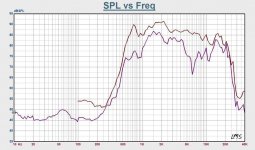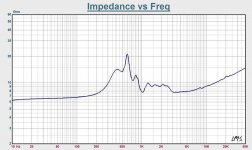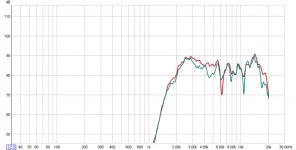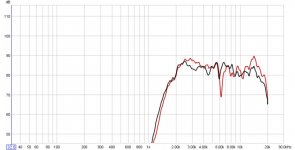OK. I've got a very strange problem.
I'm planning to use an Eminence Beta 10CX, with a higher-bandwidth driver (ie, one that can go LOWER) than the "normal" APT50 tweeter driver. A crossover point in the 1500 Hz range was my target.
My first test, was with the Beta 10CX, with a Selenium D210Ti horn driver. The driver shows very good response on the factory spec graphs... AND it tested VERY WELL on a "standard" horn I tried it on, for another project.
I have attached a graph, showing the response of the D210Ti on the "standard" horn (here's a link to a very similar, if not the exact same, horn flare: http://www.mcminone.com/product.asp?catalog_name=MCMProducts&category_name=3829617&product_id=53-880 ), and on the Beta 10CX. The top (red) plot is the driver on the "standard" horn, the bottom plot (purple) is on the Beta 10CX.
As you can see, there's SERIOUS problems at about 6KHz, with the D210Ti/Beta 10CX combination. My only cogent thought on the situation so far, is that somehow, I've got a really SERIOUS horn-throat-mismatch between the Selenium and the Beta 10CX. In fact, I don't think I've EVER seen a 20dB notch like, that EVER. Smaller notches, yes... but 20 dB? That's quite a HUGE notch!!
My current plan is to try other horn drivers (with, ostensibly, different shaped throat entrances), and see if any of them interface any better... but I hate the prospect of 'trial and error' blind parts swapping, without being able to do proper diagnostics of what's happening here. Has anyone seen this behaviour before, or has any good ideas (or even good speculations) on the mechanism that's causing this problem?
Thanks in advance...
Regards,
Gordon.
I'm planning to use an Eminence Beta 10CX, with a higher-bandwidth driver (ie, one that can go LOWER) than the "normal" APT50 tweeter driver. A crossover point in the 1500 Hz range was my target.
My first test, was with the Beta 10CX, with a Selenium D210Ti horn driver. The driver shows very good response on the factory spec graphs... AND it tested VERY WELL on a "standard" horn I tried it on, for another project.
I have attached a graph, showing the response of the D210Ti on the "standard" horn (here's a link to a very similar, if not the exact same, horn flare: http://www.mcminone.com/product.asp?catalog_name=MCMProducts&category_name=3829617&product_id=53-880 ), and on the Beta 10CX. The top (red) plot is the driver on the "standard" horn, the bottom plot (purple) is on the Beta 10CX.
As you can see, there's SERIOUS problems at about 6KHz, with the D210Ti/Beta 10CX combination. My only cogent thought on the situation so far, is that somehow, I've got a really SERIOUS horn-throat-mismatch between the Selenium and the Beta 10CX. In fact, I don't think I've EVER seen a 20dB notch like, that EVER. Smaller notches, yes... but 20 dB? That's quite a HUGE notch!!
My current plan is to try other horn drivers (with, ostensibly, different shaped throat entrances), and see if any of them interface any better... but I hate the prospect of 'trial and error' blind parts swapping, without being able to do proper diagnostics of what's happening here. Has anyone seen this behaviour before, or has any good ideas (or even good speculations) on the mechanism that's causing this problem?
Thanks in advance...
Regards,
Gordon.
Attachments
BTW: Here's an impedance plot of the D210Ti on the Beta 10CX, just in case anyone is interested or needs it. I don't see anything in the impedance plot, that gives much of any clue of a correlation with the response problem...
Regards,
Gordon.
Regards,
Gordon.
Attachments
phase_accurate said:How does the response look like with the original driver ?
Regards
Charles
I don't have an Eminence APT50 (what they originally recommended- it's not included with the Beta 10CX- you have to buy it separately) on hand to try. I may try to pick one up, just to see. I'm also going to try an Eminence PSD2002 (the one recommended for the larger Beta 12CX) since I do have one of those available...
Regards,
Gordon.
Greets!
Without taking any physical measurements or doing any tweaking, the throat/horn transition sure seems to be at least a contributing factor since the ~high Q notch around 1 kHz equates to a 6 k+ angular frequency notch, same as with Altec 1" drivers, which among other things I cured on one set of horns by replacing the cardboard gasket with a metal one and align honing the whole assembly. Makes me wonder how good the seal between the two is.
I've seen such notches in poorly loaded drivers though, so considering the lack of LF loading due to the fast flare constant, I'm wondering if reducing the rear chamber Vb to better damp that huge broadband impedance peak well below Fs might reduce it enough. That, or replace the rear cover with a well stuffed pipe.
Anyway, looking forward to your findings.
GM
Without taking any physical measurements or doing any tweaking, the throat/horn transition sure seems to be at least a contributing factor since the ~high Q notch around 1 kHz equates to a 6 k+ angular frequency notch, same as with Altec 1" drivers, which among other things I cured on one set of horns by replacing the cardboard gasket with a metal one and align honing the whole assembly. Makes me wonder how good the seal between the two is.
I've seen such notches in poorly loaded drivers though, so considering the lack of LF loading due to the fast flare constant, I'm wondering if reducing the rear chamber Vb to better damp that huge broadband impedance peak well below Fs might reduce it enough. That, or replace the rear cover with a well stuffed pipe.
Anyway, looking forward to your findings.
GM
Decided to try a couple of things, to alter/smooth, or change the dimensions of, the throat region.
Ordered one of the Selenium BOLT-ON D210Ti drivers, and a couple of bolt-on to screw-on adapters. That way, I can modify the adapters, to match the throat inside the coax.
Also, I ordered a couple of other decent drivers... B&C DE10, for one example. Maybe just a change in phase plug type/throat interface shape might make a difference too...
Much more testing to be done...
Anyone else got any ideas on further things worthy of testing?
Thanks!
Regards,
Gordon.
Ordered one of the Selenium BOLT-ON D210Ti drivers, and a couple of bolt-on to screw-on adapters. That way, I can modify the adapters, to match the throat inside the coax.
Also, I ordered a couple of other decent drivers... B&C DE10, for one example. Maybe just a change in phase plug type/throat interface shape might make a difference too...
Much more testing to be done...
Anyone else got any ideas on further things worthy of testing?
Thanks!
Regards,
Gordon.
GordonW said:
My first test, was with the Beta 10CX, with a Selenium D210Ti horn driver. The driver shows very good response on the factory spec graphs... AND it tested VERY WELL on a "standard" horn I tried it on, for another project.
I have attached a graph, showing the response of the D210Ti on the "standard" horn... and on the Beta 10CX. The top (red) plot is the driver on the "standard" horn, the bottom plot (purple) is on the Beta 10CX.
Is the response of the D210Ti only 85/90 dB SPL ???
Spec sheet shows 110 dB SPL w/ HL14-25 horn.
Re: Re: Horn Flare/driver throat mismatch causing big FR dip?
We were running much less than 1 watt. Amp gain was set for a max of around 90 dB during the test. One watt would have run both of us out of the room.
Regards,
Gordon.
Inductor said:
Is the response of the D210Ti only 85/90 dB SPL ???
Spec sheet shows 110 dB SPL w/ HL14-25 horn.
We were running much less than 1 watt. Amp gain was set for a max of around 90 dB during the test. One watt would have run both of us out of the room.
Regards,
Gordon.
There is a 10 page thread on German forum to decide which is best compression driver for Eminence 10CX. On page 9 Jobsti recommends the P.Audio D415S
Coax: Eminence Beta 10 CX mit APT-50, Lautsprecher - HIFI-FORUM (Seite 9)
My blog:
Consort3′s Blog
Coax: Eminence Beta 10 CX mit APT-50, Lautsprecher - HIFI-FORUM (Seite 9)
My blog:
Consort3′s Blog
I managed to reduce the notch significantly by placing a small roll of 'blue tack' around the lip of the metal horn.
I also placed a conical wedge of acoustic foam into the horn which smoothed out the freq response albeit with some loss of efficiency. Filter foam might work even better.
You will have to remove the dust cap to do the tweaks.
Can post before and after measurements if anyone is interested.
I also placed a conical wedge of acoustic foam into the horn which smoothed out the freq response albeit with some loss of efficiency. Filter foam might work even better.
You will have to remove the dust cap to do the tweaks.
Can post before and after measurements if anyone is interested.
Yes, I would be interested! When I was at ZilchLabs (and we tested the 10CX) we batted around the idea of inserting some sort of foam diffuser.
Please post the measurements! What frequencies did the blue-tack around the lip of the horn help?
As my 10CX's are used in a dusty environment, I would need to replace the dust cap.
Please post the measurements! What frequencies did the blue-tack around the lip of the horn help?
As my 10CX's are used in a dusty environment, I would need to replace the dust cap.
Gordon, dabbler, et all-
FYI- Here is a link to some plots on my speaker thread using the Beta 10CX w/ a Selinium D220Ti-
http://www.diyaudio.com/forums/multi-way/133490-need-good-drivers-copper-speaker-cabinet-11.html
Similar 6-7k notch. We decided to leave it for now- it performs OK in it's present use, sound re-enforcement. Off axis is a little smoother.
At some point, I'll go back to Zilch and we can tweak and run tests.
Blue tack to the rescue?
-Kent
FYI- Here is a link to some plots on my speaker thread using the Beta 10CX w/ a Selinium D220Ti-
http://www.diyaudio.com/forums/multi-way/133490-need-good-drivers-copper-speaker-cabinet-11.html
Similar 6-7k notch. We decided to leave it for now- it performs OK in it's present use, sound re-enforcement. Off axis is a little smoother.
At some point, I'll go back to Zilch and we can tweak and run tests.
Blue tack to the rescue?
-Kent
Didn't mention that I am using the Beta 12CX which seems slightly better behaved however still has the big notch at around 6k.
First graph shows the first attempt with the blue tack only on the inner rim of horn (Red original, blue mod). You can see the notch moves from 6k to above 10k. Better but still not great.
Second graph is with blue tack applied smoothly to the lip as far out as possible to form a nice round-over. Also has the conical foam wedge in there. Much better. Note I have manually eq'd down the peak at 15k before measuring. Efficiency drops with the foam which you cant see in this graph since i adjusted the offset of the second measuremnt to compare the notch. As mentioned, the 30ppi foam would probably be a much better option.
Blue tack will probably start to fall off at some stage so will need to think of a more permanent solution!
First graph shows the first attempt with the blue tack only on the inner rim of horn (Red original, blue mod). You can see the notch moves from 6k to above 10k. Better but still not great.
Second graph is with blue tack applied smoothly to the lip as far out as possible to form a nice round-over. Also has the conical foam wedge in there. Much better. Note I have manually eq'd down the peak at 15k before measuring. Efficiency drops with the foam which you cant see in this graph since i adjusted the offset of the second measuremnt to compare the notch. As mentioned, the 30ppi foam would probably be a much better option.
Blue tack will probably start to fall off at some stage so will need to think of a more permanent solution!
Attachments
Last edited:
Re-reading what we did with the 10cx in Kent's speakers, the notches disappeared off-axis, substantiating our theory that the axisymmetric round horn exit is the major culprit.
Form an elliptical mouth with bluetak and see if the notch isn't further mitigated. Show both with and without the foam to demonstrate it's role in smoothing the response, maybe.
In the end, the VHF directivity was the larger issue, which would preclude using these for hi-fi, but they were fine for PA....
Form an elliptical mouth with bluetak and see if the notch isn't further mitigated. Show both with and without the foam to demonstrate it's role in smoothing the response, maybe.
In the end, the VHF directivity was the larger issue, which would preclude using these for hi-fi, but they were fine for PA....
Last edited:
Re-reading what we did with the 10cx in Kent's speakers, the notches disappeared off-axis, substantiating our theory that the axisymmetric round horn exit is the major culprit.
Form an elliptical mouth with bluetak and see if the notch isn't further mitigated. Show both with and without the foam to demonstrate it's role in smoothing the response, maybe.
In the end, the VHF directivity was the larger issue, which would preclude using these for hi-fi, but they were fine for PA....
Probobly why we're seeing newly offered Coax's with built in waveguides as the RCF's and larger B&C's as well as others. If i'm not mistaken, possibly a CD device with a substantial phase plug might mitigate the problem, especially if the plug was slightly off axis, allowing for clock-rotational adjustmnents of the CD at it's mounting point. Not a DIY venture at all but something the big boys should try and maybe produce an acceptable Coax for high quality listening.
- Status
- This old topic is closed. If you want to reopen this topic, contact a moderator using the "Report Post" button.
- Home
- Loudspeakers
- Multi-Way
- Horn Flare/driver throat mismatch causing big FR dip?



